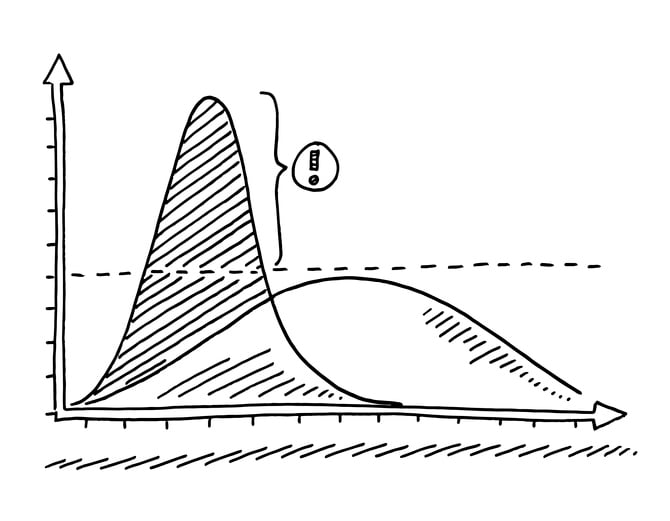
Math in Medicine: How Is Math Used in Healthcare?
When you go to the doctor, they talk to you in numbers. They measure your blood pressure, temperature, and weight. They take blood and determine whether you have the right mix of blood cells, whether your levels of certain compounds like iron and protein are high enough, and so on.
Medicine and math go hand in hand, but how much math do healthcare professionals use behind the scenes? If you’re thinking of applying to medical school or entering a healthcare field like nursing, here’s what you need to know.
Do you need to be good at math to be a doctor?
No matter the profession, it always helps to be able to perform basic mental math. That said, doctors and medical students don’t need to be math wizards. A working knowledge of simple math is often more than enough to excel in the medical field.
What math do doctors do?

Some examples of when doctors might use math include:
- Calculating medication dosages
- Interpreting medical research
- CAT scans and X-rays
- Surgical operations
- Predicting medical outcomes
Calculating medication dosages
This may be the most common application of mathematics in day-to-day medicine. Every time a doctor prescribes medicine for a patient, they have to calculate how much of the drug the patient should get and how often.
Pharmacology uses the metric system, so most dosage instructions refer to milligrams per kilogram (mg/kg) of body weight. However, most American doctors measure patients’ weight in pounds. Doctors must convert mg/kg to milligrams per pound, which requires working knowledge of:
- Ratios or fractions
- Multiplication
- Division
Interpreting medical research and data
Doctors use clinical evidence to ensure they provide the best treatment for their patients. That means reading plenty of medical literature, which relies heavily on statistics, percentages, and probability.
One common application of math is understanding the success rates of treatments. Say a research paper reports a response rate of 80% to a certain treatment, but only 50% of those patients remained disease-free a year later. A doctor would then calculate that out of 100 patients, roughly 40 would stay healthy after treatment.
Doctors use these math skills to weigh treatment options, explain the likelihood of different diagnoses, and interpret the results of screening tests.
CAT scans and X-rays
CAT (CT) scans and X-rays visualize the body using different shades of gray based on the density of body tissue. This imaging relies on mathematical functions.
Imagine machine designers and software developers must understand and implement the correct mathematical functions. Many computer scientists and biotechnology professionals are responsible for modern medical imaging technologies:
Dive Deeper: Calculus in Diagnostic Imaging Technology
CAT scan machines translate raw X-ray data into reconstructed images by solving multiple linear equations. If you want to understand what goes on inside the computer, you’ll need a background in differential equations and basic physics.
If you want to build medical technology, you will need knowledge of computing algorithms, as well as complicated mathematics such as calculus. However, physicians learn to interpret results visually. A radiologist looking at a CAT scan will rarely use math more advanced than basic arithmetic and geometry.
Performing surgery
Operating rooms work because anesthesiologists can perform mathematical calculations quickly and accurately. They use math to determine:
- The right doses of each drug.
- How much to dilute active chemicals.
- How much of each drug to deliver based on the patient’s body mass index.
The math involved in this department is mostly algebra and simple statistics.
If treatment is more advanced, a physician has to do a bit more calculating. For example, a radiation oncologist uses geometry and algebra to accurately target a tumor without overwhelming healthy cells.
Predicting outcomes
Doctors rarely have just one treatment option for a patient. To choose the right one, they use basic mathematical modeling to predict the outcomes for each option.
Mathematical modeling is the use of math concepts, formulas, and terms to describe a process — a body system, disease mechanism, chemical reaction, and so on. For doctors in the field, the math involved is usually as simple as basic algebra.
What kind of math do nurses use?

Like doctors, nurses perform basic mathematical calculations every day. Nurse practitioners (NPs) prescribe medication and develop treatment plans, so they need the same algebra and statistics skills as doctors.
Other nurses, including licensed practical nurses and registered nurses, carry out physician orders. They use high school math but rarely anything more advanced than:
- Measurements and conversions
- Fractions and percentages
- Basic arithmetic
Measurements and conversions
Nurses use math to administer the right amount of medication to each patient. Picture a nurse working in a unit where a certain medication is available in 100 and 250 mg pills. If a doctor tells the nurse to give half a gram of that medication every six hours, the nurse has to:
- Calculate how many milligrams are in a half gram (500)
- Determine how many pills to give (two 250 mg pills or five 100 mg pills every six hours)
Already, the nurse has used division, multiplication, and metric conversions. If the medication is intravenous (IV), the nurse also has to consider factors like flow rate, bag volumes, and treatment times.
Fractions and percentages
Nurses often have to calculate dosage based on body weight. This work is especially important in pediatrics, where dosing is very different for different ages.
To make sure children and adults get the right amount of medication, a nurse has to be comfortable working with fractions, decimals, and percentages.
Basic arithmetic
Nurses monitor patients by watching their vital signs—body temperature, pulse rate, respiratory rate, and so on. They need to know when readings are normal, worrying, or in the danger zone. That requires the ability to do basic calculations with whole numbers, fractions, and decimals, and compare positive and negative figures.
Best math skills for the medical field
 Healthcare professionals use basic arithmetic every day, and simple geometry and algebra less often. If it’s been a while since you’ve used these skills, start by brushing up on the following:
Healthcare professionals use basic arithmetic every day, and simple geometry and algebra less often. If it’s been a while since you’ve used these skills, start by brushing up on the following:
If your time is limited, pick one topic to study first. Statistics will be most useful if you’re a pre-med or medical student.
Did you know?
Many of edX’s medicine courses and programs, including Anatomy and Essential Human Biology, have no math prerequisites. You’ll learn any math you need to know in context, and you can apply what you learn to other healthcare fields like nutrition and biomedical imaging.
Next steps: How to brush up on math for healthcare
Basic math is important in healthcare, but you don’t need to put your studies on hold to refresh your skills. edX has a variety of overview courses in topics like continuing medical education, pre-algebra, and statistics, as well as more focused options like the three-week Linear Algebra I course from Georgia Tech.
Register for one of edX’s engaging math classes today, and prepare for a richer experience as a healthcare professional.
